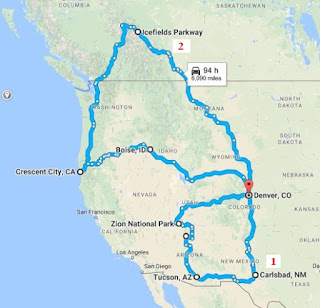Fings aren't what they used to be
Were they ever? (The original use of the title was a 1960 musical put on by the Theatre Workshop and not the Duke Ellington song which is a more grammatical "Things aren't .....)
This is a continuation of my post which looked at whether current weather patterns represent a change from the normal patterns. The conclusion I reached in the previous exercise was that temperatures were no more unusual now than in the past.
Somehow, when playing with the BoM Climate Data online series I discovered a closed weather station Canberra Airport Comparison Site which operated from 1940 to 2010. As this seemed to offer a good longer time series to assess how variable climate stuff has been I have looked at that series in conjunction with my shorter series for Carwoola.
A first point is that where years are in common between the two series the pattern is pretty similar. In view of the different technologies and methods used the level of similarity available by eyeballing is a pretty good statement that the Carwoola series is OK!
The first two graphs look at the 70 year series of maximum temperatures by month. I have counted the number of months in each year in which the observed maximum was more than 1 Standard Deviation from the average for that month.
For the cold series (ie the number of monthly values below the average less 1 SD) there is no significant trend. Thus one could suggest that the level of variability in recent years is no worse than in the past.
The rules of statistics would suggest that with a normal distribution and 840 observations 15% (or 126) would lie more than 1 SD below the average. In this case there were 135 cold observations which is a few more than would be expected. However most of the years with high numbers of aberrant months (say 5+) were in the 1940s and 1950s. This suggest recent years are closer ro average (or 'usual') that in the early years.
It is perhaps logical to find that the finding for hot months (ie the number of monthly values above the average plus 1 SD) is almost the opposite. The value of R2 for the trend line isn't great but does suggest an upwards trend.
In addition the sum of the number of aberrant months is above the expected value of 126 is higher, at 146 and the years with high values (5+) are all in the past 2 decades (especially the noughties). However the Carwoola series suggests that matters have calmed down a little in recent years. But it is difficult to say that recent years have been as usual.
Moving on to rainfall. Both series closely resemble a cross section of the Himalayas! Neither shows anything even close to a significant trend.
The numbers of years with high numbers of drier or wetter months are more evenly spread than was the case with temperatures. My conclusion with rainfall is that a high level of variability is quite normal by this measure.
This is a continuation of my post which looked at whether current weather patterns represent a change from the normal patterns. The conclusion I reached in the previous exercise was that temperatures were no more unusual now than in the past.
Somehow, when playing with the BoM Climate Data online series I discovered a closed weather station Canberra Airport Comparison Site which operated from 1940 to 2010. As this seemed to offer a good longer time series to assess how variable climate stuff has been I have looked at that series in conjunction with my shorter series for Carwoola.
A first point is that where years are in common between the two series the pattern is pretty similar. In view of the different technologies and methods used the level of similarity available by eyeballing is a pretty good statement that the Carwoola series is OK!
The first two graphs look at the 70 year series of maximum temperatures by month. I have counted the number of months in each year in which the observed maximum was more than 1 Standard Deviation from the average for that month.
For the cold series (ie the number of monthly values below the average less 1 SD) there is no significant trend. Thus one could suggest that the level of variability in recent years is no worse than in the past.
The rules of statistics would suggest that with a normal distribution and 840 observations 15% (or 126) would lie more than 1 SD below the average. In this case there were 135 cold observations which is a few more than would be expected. However most of the years with high numbers of aberrant months (say 5+) were in the 1940s and 1950s. This suggest recent years are closer ro average (or 'usual') that in the early years.
It is perhaps logical to find that the finding for hot months (ie the number of monthly values above the average plus 1 SD) is almost the opposite. The value of R2 for the trend line isn't great but does suggest an upwards trend.
In addition the sum of the number of aberrant months is above the expected value of 126 is higher, at 146 and the years with high values (5+) are all in the past 2 decades (especially the noughties). However the Carwoola series suggests that matters have calmed down a little in recent years. But it is difficult to say that recent years have been as usual.
Moving on to rainfall. Both series closely resemble a cross section of the Himalayas! Neither shows anything even close to a significant trend.
The numbers of years with high numbers of drier or wetter months are more evenly spread than was the case with temperatures. My conclusion with rainfall is that a high level of variability is quite normal by this measure.







Comments